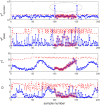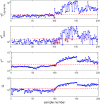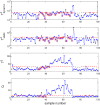Dynamic Batch Process Monitoring Based on Time-Slice Latent Variable Correlation Analysis
- PMID: 36406484
- PMCID: PMC9670696
- DOI: 10.1021/acsomega.2c04445
Dynamic Batch Process Monitoring Based on Time-Slice Latent Variable Correlation Analysis
Abstract
Batch processes are generally characterized by complex dynamics and remarkable data collinearity, thereby rendering the monitoring of such processes necessary but challenging. This paper proposes a data-driven time-slice latent variable correlation analysis-based model predictive fault detection framework to ensure accurate fault detection in dynamic batch processes. The three-way batch process data are first unfolded into the two-way time slice. For each single time slice, process data are mapped to both major latent variables and residual subspaces to deal with the variable-wise data collinearity and extract dominant data information. A measurement status is then determined with a canonical correlation analysis of the major latent variables and correlated variables, using both the time and batch perspectives. Prediction-based residuals are generated, which provide the basis for identifying the property of faults detected, namely, static or dynamic. Based on experiments using a simulated penicillin production and an industrial inject molding process, the proposed monitoring scheme has been proven feasible and effective.
© 2022 The Authors. Published by American Chemical Society.
Conflict of interest statement
The authors declare no competing financial interest.
Figures













Similar articles
-
Batch process fault detection and identification based on discriminant global preserving kernel slow feature analysis.ISA Trans. 2018 Aug;79:108-126. doi: 10.1016/j.isatra.2018.05.005. ISA Trans. 2018. PMID: 29776590
-
On-line monitoring of batch processes based on PCA: does the modelling structure matter? [corrected].Anal Chim Acta. 2009 May 29;642(1-2):59-68. doi: 10.1016/j.aca.2009.02.001. Epub 2009 Feb 11. Anal Chim Acta. 2009. PMID: 19427459
-
Sparse Wasserstein stationary subspace analysis for fault detection and diagnosis of nonstationary industrial processes.ISA Trans. 2024 Aug;151:285-295. doi: 10.1016/j.isatra.2024.05.043. Epub 2024 May 30. ISA Trans. 2024. PMID: 38845235
-
Adaptive two-dimensional subspace identification for monitoring batch processes with limited batch data.ISA Trans. 2024 Sep;152:408-426. doi: 10.1016/j.isatra.2024.06.031. Epub 2024 Jul 10. ISA Trans. 2024. PMID: 39033077
-
A novel approach of NPSO on dynamic weighted NHPP model for software reliability analysis with additional fault introduction parameter.Heliyon. 2019 Jul 29;5(7):e02082. doi: 10.1016/j.heliyon.2019.e02082. eCollection 2019 Jul. Heliyon. 2019. PMID: 31388570 Free PMC article. Review.
References
-
- Rendall R.; Chiang L. H.; Reis M. S. Data-driven methods for batch data analysis–A critical overview and mapping on the complexity scale. Comput. Chem. Eng. 2019, 124, 1–13. 10.1016/j.compchemeng.2019.01.014. - DOI
-
- Rato T. J.; Reis M. S. Optimal selection of time resolution for batch data analysis. Part I: Predictive modeling. AIChE J. 2018, 64, 3923–3933. 10.1002/aic.16361. - DOI
-
- Zhu J.; Wang Y.; Zhou D.; Gao F. Batch process modeling and monitoring with local outlier factor. IEEE Trans. Control Syst. Technol. 2018, 27, 1552–1565. 10.1109/TCST.2018.2815545. - DOI
-
- Gao Z.; Cecati C.; Ding S. X. A survey of fault diagnosis and fault-tolerant techniques—Part I: Fault diagnosis with model-based and signal-based approaches. IEEE Trans. Ind. Electron. 2015, 62, 3757–3767. 10.1109/tie.2015.2417501. - DOI
-
- Yin S.; Ding S. X.; Xie X.; Luo H. A Review on Basic Data-Driven Approaches for Industrial Process Monitoring. IEEE Trans. Ind. Electron. 2014, 61, 6418–6428. 10.1109/tie.2014.2301773. - DOI
LinkOut - more resources
Full Text Sources

